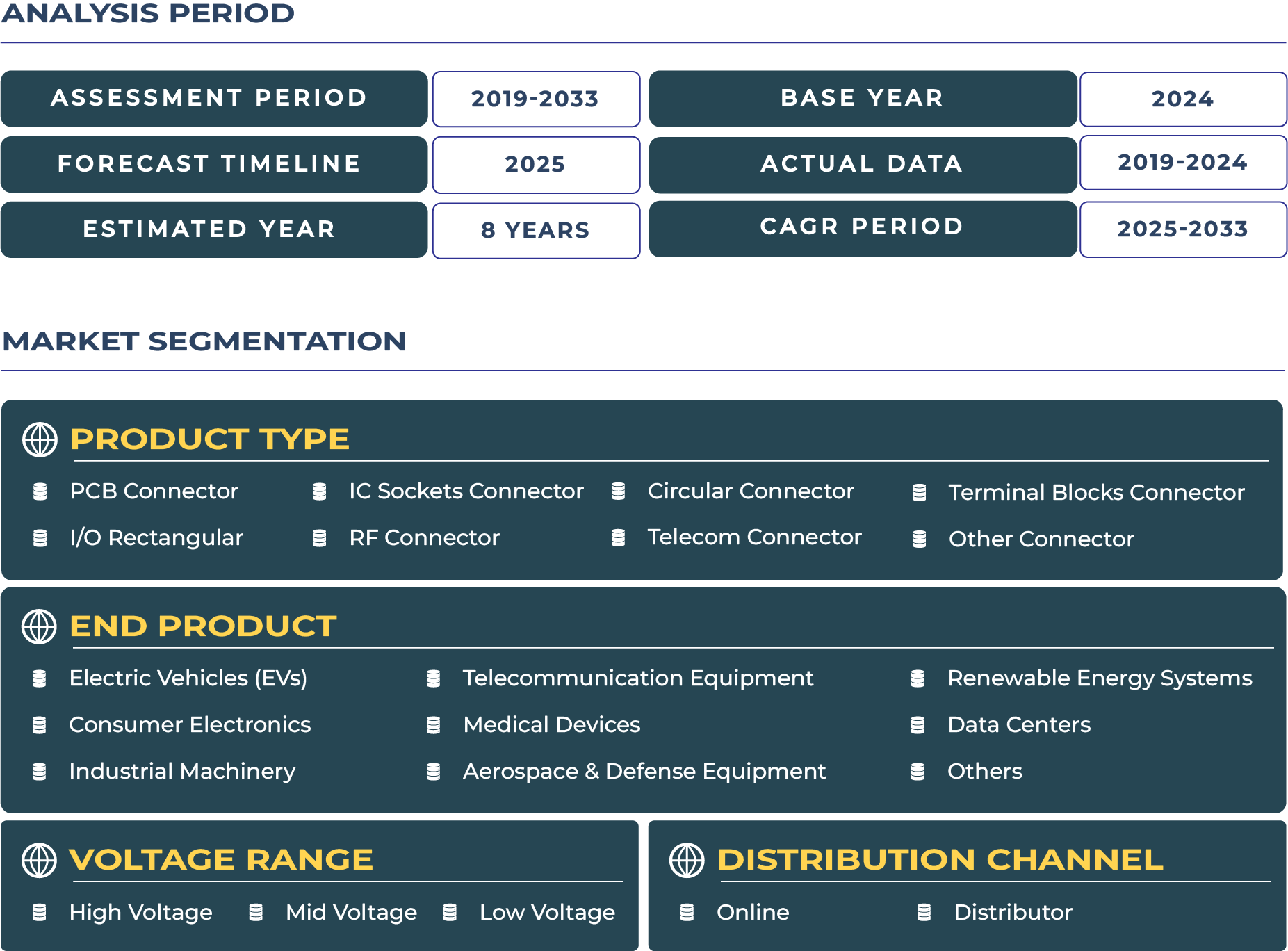Mexico Connector Market Outlook
The Mexico connector market is entering a defining growth phase, supported by the country’s sweeping advancements in telecommunications, energy, and infrastructure. As per David Gomes, Manager – Semiconductor, the market is expected to witness 5.3% CAGR during the forecast period, Mexico is rapidly aligning its digital and energy frameworks through high-impact investments, particularly in 5G deployment, grid modernization, and data center ecosystems. This shift is fueling demand for advanced fiber-optic, RF, and high-frequency connectors that are vital for the seamless integration of telecom, energy, and industrial systems. With over $2.3 billion invested in telecom infrastructure by private players like Telmex, Megacable, and Totalplay, and initiatives like “Internet para Todos” targeting 25 million underserved residents, demand is surging for robust connector solutions that enable last-mile connectivity, fiber rollouts, and scalable broadband networks.
The exponential growth in connected 5G devices—from 16.9 million in 2025 to a projected 87 million by 2030—is amplifying the role of RF connectors and modular interconnects in low-latency, high-speed transmission environments. At the same time, Mexico’s spectrum fee model has been a double-edged sword. While it reflects high asset value, it also limits aggressive network expansion, prompting players like Telefónica México to explore cost-efficient models. Telefónica’s collaboration with Helium to implement decentralized, blockchain-based wireless infrastructure is one such innovation transforming the need for low-power, distributed connector systems that support peer-to-peer data flow, thereby minimizing reliance on traditional tower-based interconnect networks.
On the energy side, Mexico is planning 51 major electricity projects through 2030, with 6,400 MW coming from private clean energy investments. This transition is dramatically reshaping demand for high-voltage connectors, power busbar systems, and ruggedized interfaces required in renewable energy deployments. The integration of 4.67 GW in solar and 2.47 GW in wind capacity necessitates not only weatherproof and industrial-grade connectors but also energy storage interface systems. Battery storage projects, with over $2.3 billion in funding, depend heavily on insulated, heat-resistant connectors to maintain safety and performance across distributed grid operations. Indigenous communities and rural electrification programs—backed by $685 million in federal funding—are also creating niche connector demand for remote access points, microgrid deployments, and modular energy units tailored for underserved geographies.
Simultaneously, the data center boom led by AWS, Google Cloud, Microsoft, and ODATA is reshaping connector architecture requirements in digital infrastructure. The deployment of Dense Wavelength-Division Multiplexing (DWDM) from Monterrey to Querétaro reflects rising demand for high-density, low-latency fiber connectors supporting hyperscale applications. Querétaro’s position as a hyperscale hub underscores the need for scalable interconnects capable of handling AI and edge computing workloads. With projections of a $73.5 billion GDP contribution by 2029 from the data center sector alone, the connector ecosystem is expanding to include high-speed backplane connectors, QSFP-DD modules, and ruggedized ports to withstand thermal and electromagnetic demands.
Moreover, Mexico’s physical infrastructure development—such as the $22.3 billion investment in industrial facilities, electricity expansion, and transport corridors like the Mexico-Querétaro Train—is generating significant demand for circular connectors, panel interface connectors, and heavy-duty cable harnesses suited for rail, energy, and manufacturing environments. Smart city infrastructure, powered by expanded fiber and IoT frameworks, adds to the surge in sensor-level micro connectors, which are critical for urban automation and environmental monitoring systems.
Despite these growth vectors, challenges persist. Regulatory barriers such as high telecom spectrum costs, dependency on natural gas for 70% of energy generation, and fiscal constraints in large-scale rural projects pose risks to market scalability. As per David Gomes, addressing these limitations requires harmonizing public-private partnerships, fast-tracking indigenous stakeholder engagement, and supporting local connector manufacturing ecosystems to reduce import dependency. Strengthening national supply chains and aligning them with sustainability goals will also be critical to mitigate global component shortages and meet future demand.
Ultimately, the Mexico connector market is expected to experience sustained growth over the forecast period, reflecting the convergence of digital connectivity, energy transition, and infrastructure modernization. With the right blend of policy reform, technological innovation, and inclusive growth, Mexico is poised to become a regional benchmark for intelligent, resilient infrastructure powered by next-gen connector technologies.
Authors: David Gomes (Manager – Semiconductor)
*Research Methodology: This report is based on DataCube’s proprietary 3-stage forecasting model, combining primary research, secondary data triangulation, and expert validation. [Learn more]







